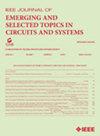Intermetallic Compounds (IMCs) Growth Investigation, Kinetic Parameter Analysis and Reliability Evaluation of In Solder Metal for 3D Integration Packaging
IF 3.8
2区 工程技术
Q2 ENGINEERING, ELECTRICAL & ELECTRONIC
IEEE Journal on Emerging and Selected Topics in Circuits and Systems
Pub Date : 2025-07-21
DOI:10.1109/JETCAS.2025.3591363
引用次数: 0
Abstract
The increasing demand for higher functional density in microelectronics necessitates the miniaturization of interconnects in 3D integration, which presents challenges in processing and reliability. During fabrication and service life, interconnect microbumps remain in a non-equilibrium state, leading to interfacial reactions and atomic diffusion that drive intermetallic compounds (IMCs) growth and phase transformations, impacting the electrical, thermal, and mechanical properties, and affecting long-term reliability. With global restrictions on Pb-based solders, indium (In) has emerged as a viable low-melting-point alternative, especially for temperature-sensitive packaging. Understanding IMCs kinetics in In-based systems is essential for optimizing reliability. This study investigates the kinetics and phase transformation of IMCs in Ni/In and Cu/In systems under solid-state aging conditions using an in-situ resistance measurement technique. The approach overcomes the limitations of traditional scanning electron microscopy (SEM)-based analysis by enabling continuous monitoring of IMCs growth. The Ni/In system forms Ni3In7 through a reaction-controlled mechanism with an activation energy of三维集成封装中金属钎料金属间化合物(IMCs)生长研究、动力学参数分析及可靠性评价
微电子技术对高功能密度的需求日益增长,使得三维集成互连的小型化成为必然,这在加工和可靠性方面提出了挑战。在制造和使用寿命期间,互连微凸点保持在非平衡状态,导致界面反应和原子扩散,从而驱动金属间化合物(IMCs)的生长和相变,影响电学、热学和机械性能,并影响长期可靠性。随着全球对铅基焊料的限制,铟(In)已经成为一种可行的低熔点替代品,特别是对于温度敏感的包装。了解基于in的系统中的IMCs动力学对于优化可靠性至关重要。本研究利用原位电阻测量技术研究了Ni/ in和Cu/ in体系中IMCs在固态时效条件下的动力学和相变。该方法克服了传统的基于扫描电子显微镜(SEM)分析的局限性,实现了对IMCs生长的连续监测。Ni/In体系通过反应控制机制生成Ni3In7,活化能为$108~ $ pm ~ $ 30 kJ/mol。在Cu/In体系中,Cu/In在室温下形成CuIn2,并通过等温时效107.5~^{\circ}$ C以上的准晶反应转变为Cu11In9。从$110~ $ {\circ}$ C (n $\约~0.73$)的反应-扩散混合控制转变为$ 120 ~ $140~ $ ^{\circ}$ C (n $\约~0.45$ ~ 0.62 $)的扩散控制,并可能转变为$150~ $ {\circ}$ C (n $\约~0.19$)的晶界扩散。CuIn ${}_{2} \到$ Cu11In9的转变活化能为$196~ $ pm ~ $ 82$ kJ/mol,表明存在较高的能垒。这些发现有助于低温键合技术的发展和未来微电子封装的细间距互连优化。
本文章由计算机程序翻译,如有差异,请以英文原文为准。
求助全文
约1分钟内获得全文
求助全文
来源期刊

IEEE Journal on Emerging and Selected Topics in Circuits and Systems
ENGINEERING, ELECTRICAL & ELECTRONIC-
CiteScore
8.50
自引率
2.20%
发文量
86
期刊介绍:
The IEEE Journal on Emerging and Selected Topics in Circuits and Systems is published quarterly and solicits, with particular emphasis on emerging areas, special issues on topics that cover the entire scope of the IEEE Circuits and Systems (CAS) Society, namely the theory, analysis, design, tools, and implementation of circuits and systems, spanning their theoretical foundations, applications, and architectures for signal and information processing.
 求助内容:
求助内容: 应助结果提醒方式:
应助结果提醒方式:


